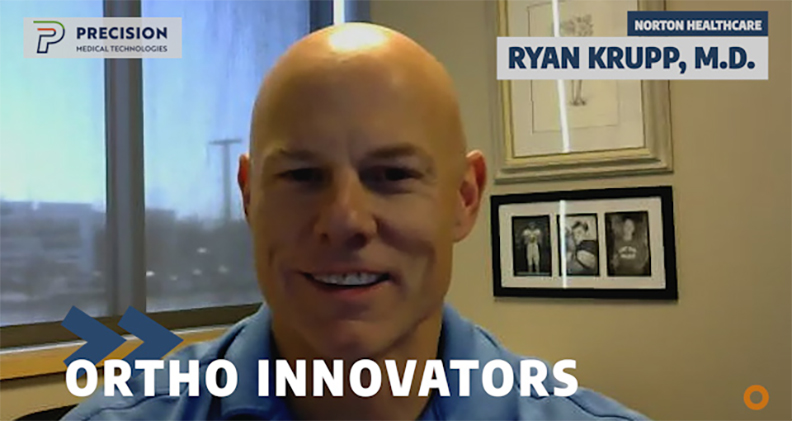
Dr. Krupp is an orthopedic surgeon with Norton Orthopedic Institute and Executive Medical Director of Orthopedics and Sports Health and Shoulder Reconstruction for Norton Healthcare. He’s also actively involved in industry’s product development efforts, with a particular interest in shoulder replacement and rotator cuff repair. We connected with Dr. Krupp to talk about performing surgery with a soft touch, the importance of data-driven feedback loops that inform implant designs and why an unfortunate injury fueled his passion for improving patient care.
What inspired you to pursue a career in orthopedics?
In high school, I suffered an open tibia fracture while playing basketball. The injury became my introduction to orthopedics and showed me the impact the specialty can have on someone’s life. From that point on, orthopedics always felt like a natural fit because it aligned so well with my strengths and interests. I enjoy analyzing problems, assessing solutions, taking action and seeing tangible results. The mechanically driven nature of orthopedics also resonates with me, particularly given my undergrad degree in chemical engineering.
You were on the surgeon design team that helped develop the ROSA Shoulder System. What excites you about the robot’s potential to improve shoulder replacement outcomes?
I’ve worked extensively with Zimmer Biomet on teaching and product development projects, and one of the most exciting areas we’re exploring is robotics, which can help eliminate outliers, ensure more consistent results and keep outcomes within a reliable range. High-volume surgeons generate substantial amounts of clinical data, which can be analyzed using AI. We could compare operative plans to best practices derived from the collective data of top-performing surgeons. That information could be used to adjust surgical plans and suggest optimal implant placements to improve outcomes.
What developments have the potential to address the challenges of rotator cuff repair?
Much of the focus has been on the mechanical integrity of rotator cuff repairs. However, we’re now starting to explore the biological aspects of healing, including interventions like collagen scaffold grafts, platelet-rich plasma and similar approaches. While orthobiologics are a promising area of research, we’ve only begun to scratch the surface of their real-world potential.
How is interest in minimizing damage to soft tissues and bone impacting implant development?
I was involved in the design of Zimmer Biomet’s OsseoFit Stemless Shoulder System, and one of the key drivers was its bone-preserving construct. Removing less bone results in less post-op pain, better outcomes if revision surgery is needed and potentially improved fixation that allows the implants to remain in place longer. As people live longer — and increasingly receive implants at younger ages — it’s crucial to optimize these features to provide better long-term solutions. The challenge, however, is finding the right balance. Innovations that preserve bone and soft tissue must also ensure that the surgery is performed with the precision and reliability needed for successful outcomes. Otherwise, the trade-offs become counterproductive.
Why is it important to focus on solutions that are backed by clinical data?
The synergy between implant design and advancing technology is exciting. The next step is where it gets even more powerful. We can collect and analyze outcomes data with artificial intelligence to evaluate whether a device did in fact deliver the best possible outcome. This feedback loop allows us to continually refine and optimize designs for future patients. Knowledge is power, and having this level of insight will revolutionize how we approach orthopedic care. Over the next five to 10 years these advancements will drive an exciting evolution, giving us the tools to achieve better outcomes, improve implant designs and refine implementation techniques. It’s an incredible time for innovation in orthopedics.
DC
Dan Cook is a Senior Editor at ORTHOWORLD. He develops content focused on important industry trends, top thought leaders and innovative technologies.




